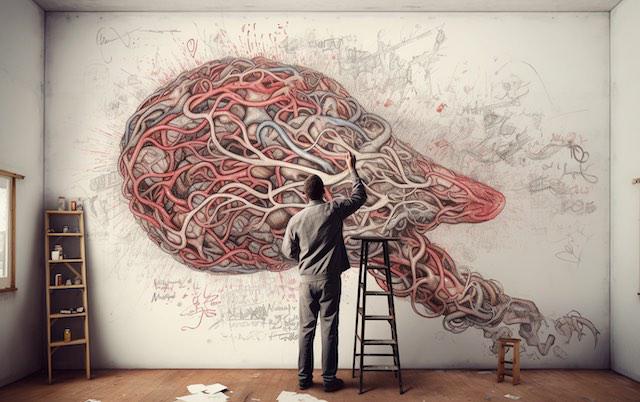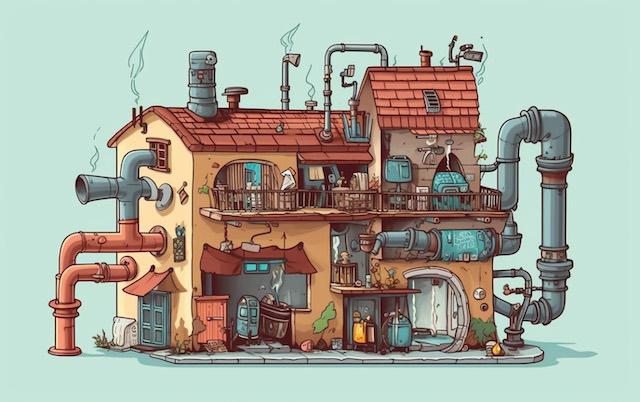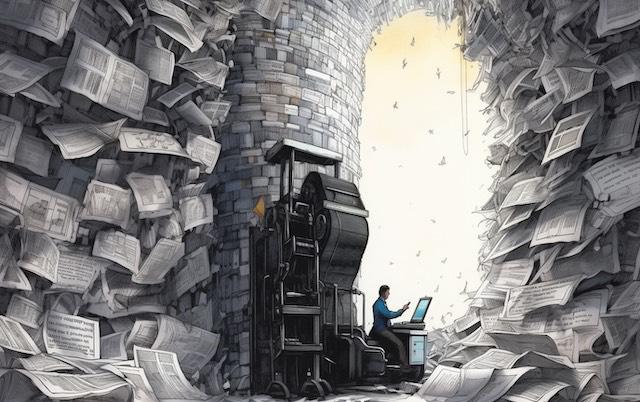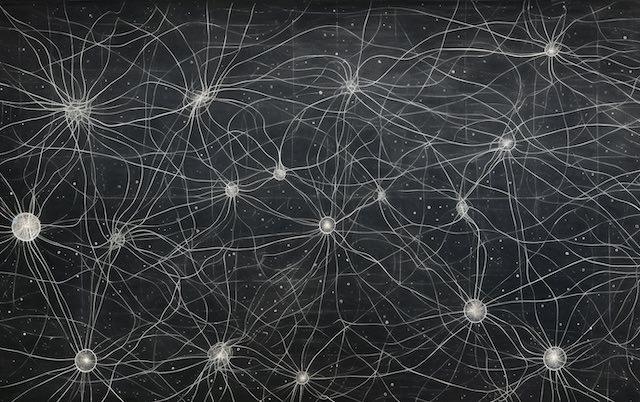The Evolution of Intelligence Itself
AI is not alien, it’s us.
By Philip Winston |
ENIAC, the first programmable general-purpose electronic computer, completed in 1945, could execute four hundred floating-point operations per second: 400 FLOPS. Nearly 80 years later, in 2022, the fastest supercomputer can perform over one quintillion operations per second: 1.1 exaFLOPS. It took us only 80 years to progress from 400 FLOPS to 1,100,000,000,000,000,000 FLOPS.
Once you have enough atoms, you start doing chemistry, once you have enough molecules, you start doing biology, and once you have quintillions of FLOPS you start doing AI. Because it’s digital, AI will not have the limitations of our biology, it will not be beholden to our evolutionary history, it will not have the physical constraints of our human-sized skull, it will not limit itself to our senses, our intuitions, or our memory. We are entering the era of the evolution of intelligence itself, an evolution which will never end.

The AI advances of 2022, including AI Art and ChatGPT, drastically changed my feelings about how good AI is likely to become during my lifetime. Unlike past breakthroughs such as AlphaGo and AlphaFold, these new AI systems are accessible to everyone, and everyone who used these systems hands-on reached the same conclusion: AI is suddenly good.
That AI is now able to create text and images this well is a historic event. Humans have been creating images since the Maltravieso Cave paintings some 50,000 years ago, and we’ve been writing for more than 5,000 years. For that entire time, if you saw human-level images or writing, you knew that humans had made them. Today that is no longer true, and this is just the beginning, generative AI will soon produce every type of media: images, videos, movies, screenplays, novels, poems, music, video games, and more.
Despite the dramatic progress — or perhaps because of it — people’s reactions to these AI systems are mixed. Some welcome an AI future, while others express serious concerns, even anxiety, alarm, and fear. Will AI take over my job? Will AI take over everyone’s job? Even if the government gives us a Universal Basic Income, how will we find meaning and purpose without work? If there’s nothing left for us to do, will the AIs even want us around? Will they turn the Earth into a nature preserve, force us to return to subsistence farming, and keep us as pets in a globe-spanning terrarium while the AIs explore the stars?

I think these concerns are legitimate, but the benefits of AI could immense. AI has the potential to improve every human endeavor, since almost everything we care about requires intelligence. AI will result in tremendous and ongoing improvements in energy, manufacturing, transportation, resource management, poverty, health, medicine, education, science, space exploration, politics, entertainment, and more. I think we are thoughtful and careful we can navigate around the dangers. Furthermore, I take great comfort in the fact that AI is inevitable; we could no more choose a future without AI than we could have kept humans from adopting electricity or indoor plumbing. Since it’s going happen regardless, we might as well manage it the best we can.
It’s a complication that we have no pre-existing mental category for AI. There has never been a non-human intelligence at our level or beyond. People suggest that we think of AI as alien, but to me that strikes the wrong tone, it invites us to think of AI as mysterious and even threatening and scary. Instead, I’d equate AI with something we have in spades here on Earth, something that itself is super-intelligent, something we already have a deep familiarity with: organized groups of people.
Imagine the writer’s room of a hit TV show, sweaty wordsmiths hammering together a script one joke at a time. Imagine a seasoned rock band on the tail end of a long tour, anticipating each other’s every musical change. Imagine an agile startup company with a twenty employees collaborating late into the night, or a powerful multi-national mega-corporation with a hundred thousand workers servicing billions of customers. Imagine a university, the busy kitchen at a great restaurant, the emergency room at a hospital, a championship sports team, a battalion of soldiers, or an entire country. Our ability to coordinate in small and large groups is one of the defining traits of our species, and interacting with or being a part of these groups is central to the human experience.
So when we see an AI doing something “super-human,” we should visualize a team of people — it could be two people or two hundred thousand people. We should also consider the duration; imagine this group of people working for a minute, an hour, or a hundred years, depending on the task. In all cases, it’s not magic; it’s a lot of hard work compressed into a small amount of time and space.

A lot of the work behind an AI happened during its training. We train modern AIs on ever-larger piles of training data, feeding them petabytes of text and images from billions of separate documents, millions of hours of video and audio. AI training datasets have grown so large that we are approaching the point where we train AIs on everything; we will soon be training them on everything humans have produced during our entire history.
AIs are not alien; they were conceived and built by humans and trained on the collected work output of humans, so AIs are more human than human; they are humanity concentrated and compressed. Soon we will start feeding the resulting concoction into every individual intravenously, for fractions of pennies per dose, giving all of us the power of the whole. Any civilization that lasts long enough would create this same technology, it’s just too obvious and too effective, and we now know it’s possible.
I find the inevitability of AI comforting. It is evolution that brought us here, and it is evolution that is pushing us forward. By evolution, I mean the broader force for incremental change, which we see in the biological evolution of DNA-based life, but also in many other forms. Physics evolved into chemistry which evolved into biology; biology evolved humans, who created language and writing, which led to human culture, a culture which instantly started evolving faster than biology. This evolution of culture produced technology, and technology eventually led to the creation of electronic digital computers, which immediately started to evolve as well, by our hands.

Humans first came up with the idea of using brain-inspired artificial neural networks in 1943, two years before the Army completed ENIAC, but it turned out conventional computers were much easier to build and program, so we focused our attention on them for the rest of the twentieth century. Yet that worked out wonderfully because we built modern AI symbiotically on the backs of conventional computers; we leveraged our traditional software infrastructure and used much of the same hardware. We weren’t off track building regular computers, it was a necessary bootstrapping process, but it appears that the boot has been sufficiently strapped.
At the heart of today’s AI are artificial neural networks, mathematical constructs that were inspired by the structure and organization of our brains, a structure and organization that biological evolution concluded was the best way to perform computations using meat. A single brain cell is comprised of 100 trillion atoms fashioned into insanely complex molecular machines, physically interacting with each other to generate that neuron’s behavior. Artificial neural networks replace the complexity of a neuron with a single floating-point number for each “synapse” in the network. These numbers are the “weights” or “parameters” of the AI model. The artificial version is massively simpler than the real thing, which is why it’s amazing that it works so well.
By the end of 2022, I finally felt, in my bones, that artificial neural networks, this cartoonishly simple imitation of brain wiring, can be as effective as the real thing. This realization drastically changes my sense of how our technology will develop for the rest of the century, and beyond. We will build an endless stream of larger and more sophisticated neural networks and use them to solve our hardest problems. If an individual neural network tops-out at some given size, we can create many different ones and wire them together. Our own brains use this approach: they can be divided into as many as 180 different regions; regions which evolved for different purposes along different evolutionary paths.
The future of AI is building and then iterating on these individual regions, improving and optimizing the parts, then turning our attention to the larger architecture created by assembling those regions, and AI will assist us every step of the way. The result will be dozens to hundreds of differently trained neural nets, wired together, operating as a tight knit system, performing at a human-level or far beyond, in every domain.
Read More
from Hacker News https://ift.tt/p7iGN2u
No comments:
Post a Comment
Note: Only a member of this blog may post a comment.